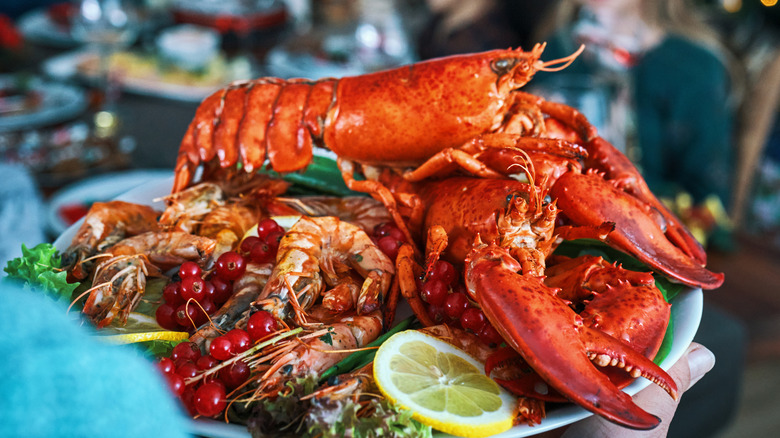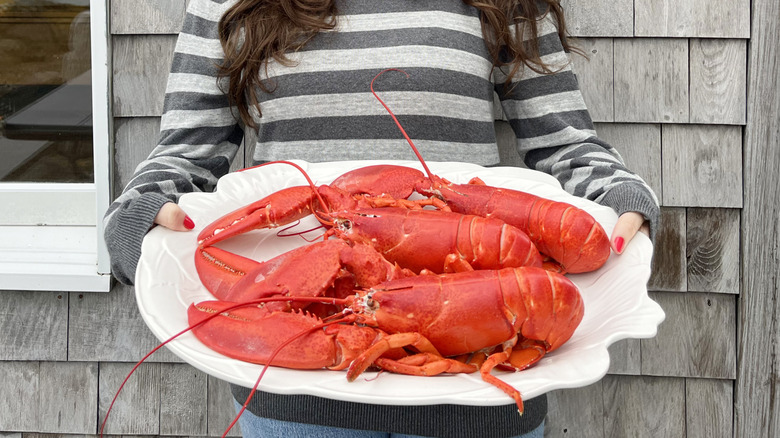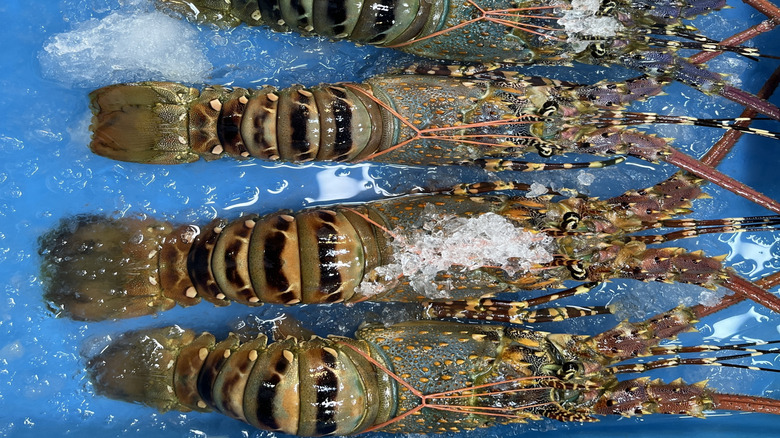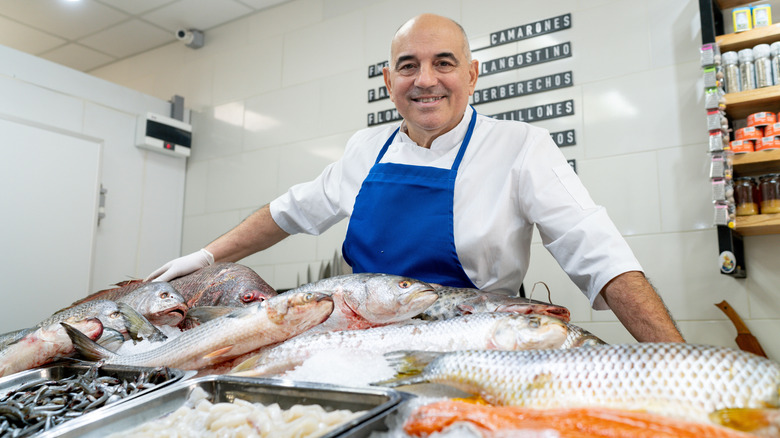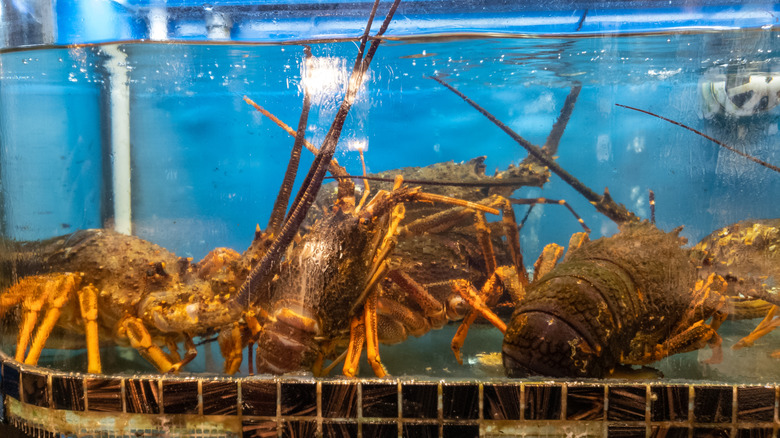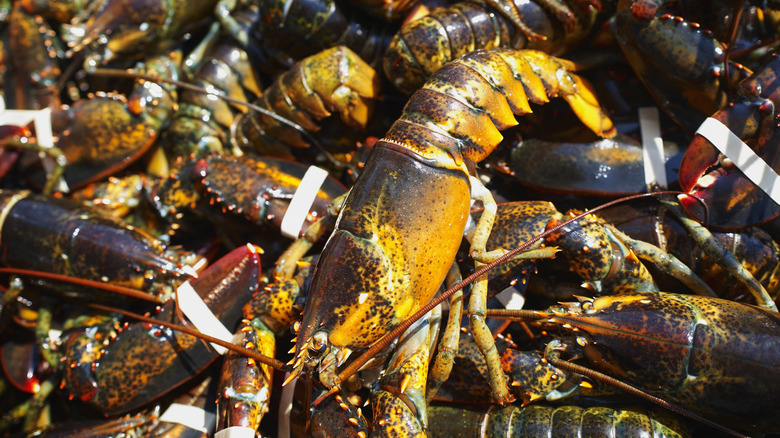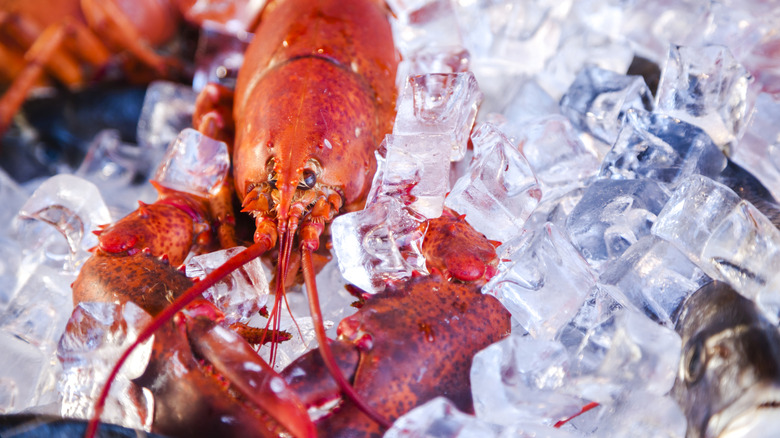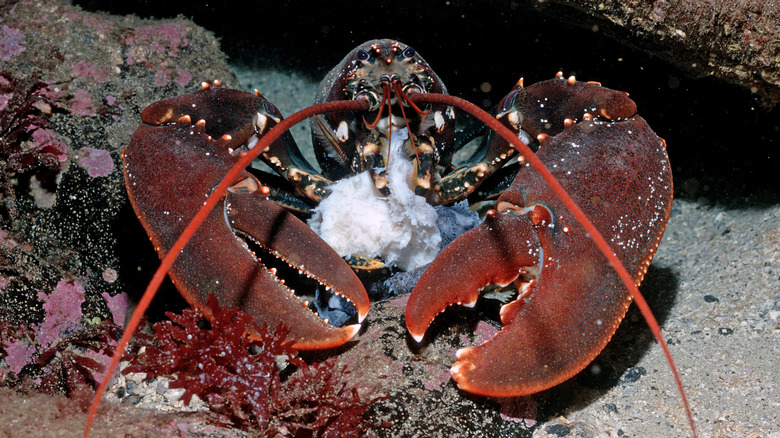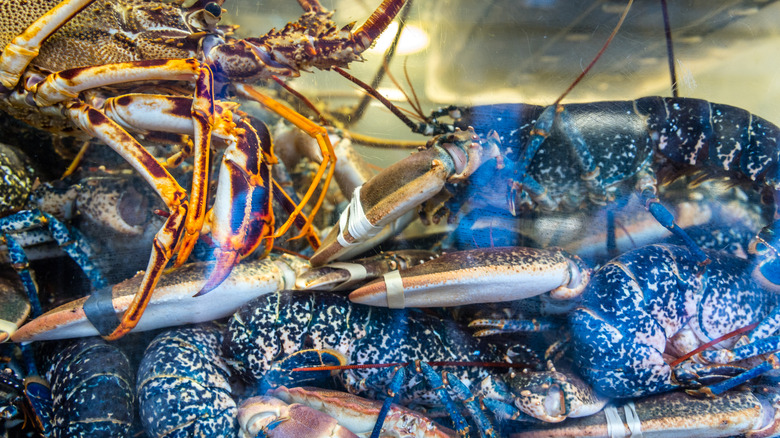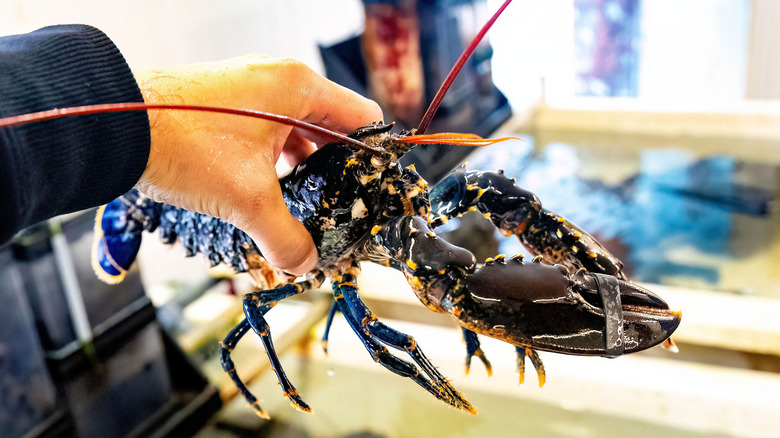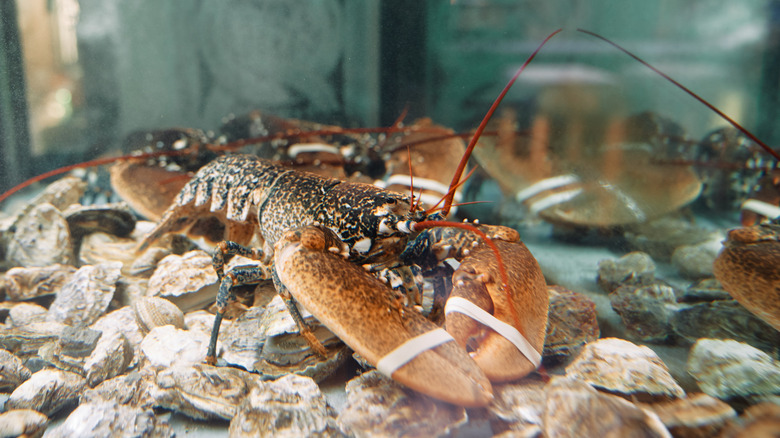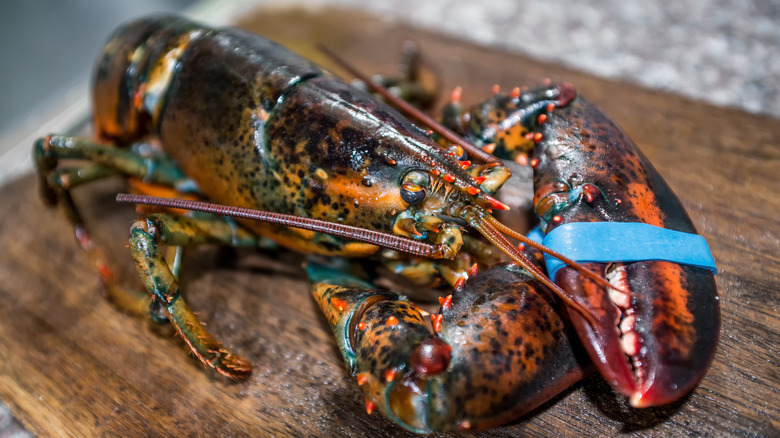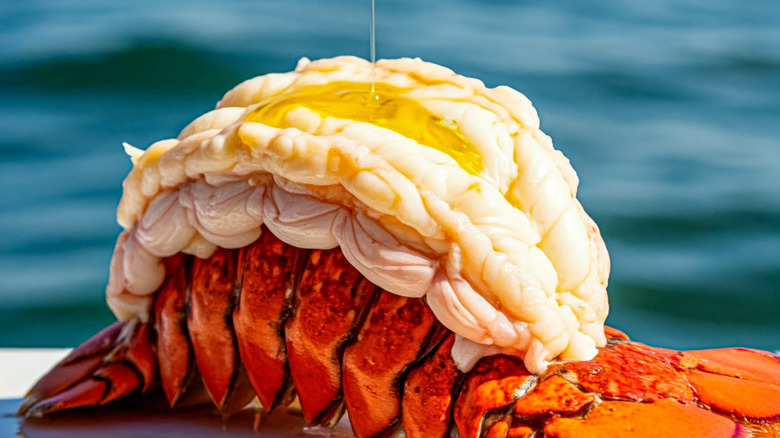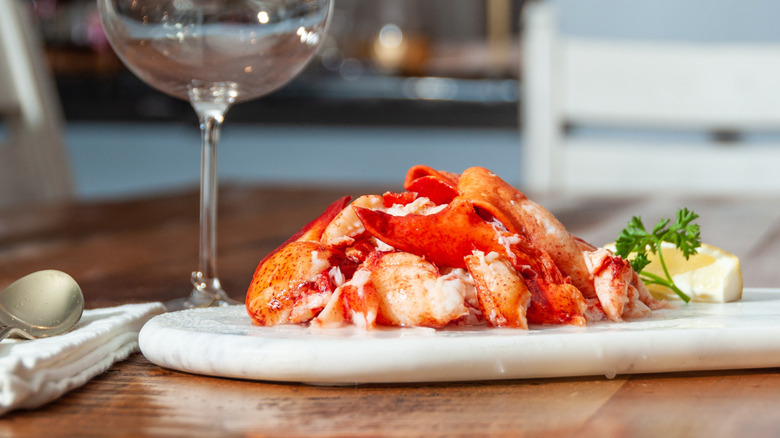The 16 Most Important Red Flags To Look Out For When Buying Lobster
Lobster is widely regarded as a delicacy. So much so that you'd never guess its history as an American prison food and a mainstay of servant meals, to the point that they wrote exemptions from lobster meals into their contracts. Hoi polloi of today have to pay much higher prices, and therefore have to be much more careful to get a good product.
Making this more difficult is the fact that there is wide variation in lobster quality, according to the chefs with whom Chowhound spoke. Whether you're planning to grill lobster, butterfly the tail for pan-searing or poaching, or make lobster roll fries, you want to get the best lobster you can find. With a good specimen, you can even use lobster shells to make stock for bisque or stew, or just flavor a risotto. But finding that high-quality lobster is not as intuitive as you might think.
On the upside, says Daniel Witwer, executive sous chef at The Darling Oyster Bar, "There are a ton of options on the market." They use live lobsters, but "other options include dry-packed lobster meat, frozen, warm-water lobsters, and pre-cleaned meat. Beyond this, you can request specific parts of the lobster, such as tails, claws, knuckle meat, and more." With so many choices available, and so many things that can go wrong, it's critical that you know what you're looking for — or rather, what to avoid. Here are 16 red flags to watch out for today.
1. No information about lobster type
The biggest mistake when buying a lobster is to choose a big 'un and leave it at that. Whether you plan to parboil lobster for easy shell removal or serve them whole doesn't matter; what matters is that you get a good-quality specimen to ensure a good-quality meal. And that, in turn, means you need some information to work with. Failure to provide it is one of the biggest red flags that your grocery store, fishmonger, or brand isn't peddling the best goods.
Lobsters are an incredibly popular ingredient, but they're not all the same. For instance, explains Julia Chebotar, private chef at Health Chef Julia, "Live lobster is typically available year-round, especially from cold-water regions like Maine and Canada, but peak season runs from late spring through early fall."
There are, moreover, many different types. "American (Maine) lobster is the most widely consumed in the U.S. and known for its large claws and sweet, tender meat. Spiny lobsters, which are clawless and have a firmer texture, are found in warm waters, especially Florida, the Caribbean, and Southern California." These are typically a fall product and are beloved for their tails. Whatever option you prefer, the type and source of lobster should be clearly stated by the seller.
2. No distinction between hard and soft shells
Another of the red flags when it comes to choosing lobster is if the purveyor fails to indicate whether it is hard-shell or soft-shell. There's a difference between hard- and soft-shell lobsters, but it's not in the species itself. Rather, as with soft-shell crabs, a soft-shell lobster is simply a hard-shell specimen that has recently shed its constraining old shell and is growing a new one. However, that shedding makes for a different product than a lobster whose current shell has hardened. While both are good, you should be apprised of the difference when buying them.
"Don't underestimate the difference between soft-shell and hard-shell lobsters," Julia Chebotar says. "Soft-shells are easier to crack and slightly sweeter, but they contain less meat. Hard-shells are meatier and better for recipes where texture matters." If your recipe calls for one or the other, pay attention, and make sure you have a fishmonger who can guide you in choosing a lobster that meets your needs. Also, James Callery adds, "Soft-shell lobsters generally mean less meat and shorter shelf life."
3. The fishmonger can't provide details or instructions
As red flags go, lack of information on the label is a pretty serious one, but if your fishmonger can't even clear things up, that's bad. "They should know when and where the lobster was caught and how it was stored," says Grace Vallo, founder of the recipe blog Tastefully Grace. "If they don't know the source or how long they've been in the tank, don't buy. Look for someone knowledgeable and communicative!"
James Callery, Head Chef at The Fairview Restaurant at Sandford Springs, agrees. "Your fishmonger should be able to answer every question you throw at them without hesitation," he says. "They should tell you whether it's a hard-shell or soft-shell and how long it's been in their tank. If you're buying meat or tails, they should disclose if it was previously frozen and how it's been handled." He includes storage instructions, shelf life, and traceability — both to where it was caught and the boat that did the catching — in that list as well. If the answers are vague or the fishmonger seems confused, look elsewhere, Callery advises. "A reliable fishmonger is as important to a chef as a good knife — and a lot harder to sharpen."
Lastly, the fishmonger should also be able to help you with cooking questions. This is critical, since there are better and worse ways to cook lobster, as well as more and less humane ways. For instance, Julia Chebotar says, "If you're cooking live lobster at home, be respectful of the process. A quick, humane method is to chill the lobster in the freezer for 15 to 20 minutes before cooking."
4. Signs of prolonged storage
One of the biggest red flags when choosing lobsters is any sign of prolonged storage in the tank. "When choosing your lobster, think of it like picking produce," says Rima Kleiner, dietitian at Dish on Fish. "You want the freshest option available." Not only do you want fresh lobsters for the sake of the best flavor and texture, but it's cruel to the lobster to keep them around too long.
Daniel Witwer recommends you keep your eye out for dirty bands on the claws and/or algae or other types of residue on the shell. "These signs can suggest that the fishmonger or distributor has kept them in a facility for a period of time," he explains. The purveyor has an obligation to you to provide this information, though, so feel free to ask.
Regarding storage, make sure you don't prolong it at home, either. "Cooking live lobster soon after purchase is key," Grace Vallo says. "You should cook live lobsters the same day." She advises that you cover lobsters with a damp paper towel in the fridge, rather than submerging them in water, until you're ready to cook them.
5. Lack of sustainable practices
Sustainability is important, and that's as true with lobsters as anything else. "There are many protocols and regulations around when and where seafood can be sourced," Daniel Witwer. "For instance, if there is a flood or some other natural occurrence that is disturbing the animal's natural habitat, it is mandated that the animal cannot be caught during those periods." The same goes for seasonality, he says. Different regions have different rules regarding when seafood is safe for consumption, depending also on whether the water is warm versus cold, or salt versus fresh.
"It's important for your purveyors and distributors to have both an understanding of the ecosystem in which they are sourcing their product and the seasonality of said product," Witwer says. If it's clear they don't, go elsewhere for lobster. You can look for these red flags at restaurants as well as grocery stores, by the way; a good restaurateur or chef will have answers ready. "We partner with sustainable farmers and purveyors to ensure that the practices they are using are not inhumane in any way and ultimately, will not affect the product we are sourcing from them," Witwer adds.
6. Cracked, mushy, or discolored shells
"For live lobsters, look for active ones with intact, hard shells," Rima Kleiner says. Cracked, mushy, or discolored shells are all major red flags. "Cracks can indicate rough handling or poor health, while a mushy shell suggests the lobster is weak or has begun to deteriorate." Shells may also be soft because the lobster is in its soft-shell stage, of course, but this should be clearly disclosed. A mushy hard-shell is a bad sign indeed.
Cracks also suggest that the lobster has been around too long, Daniel Witwer says. When lobsters are kept in confined spaces for too long, they start to fight with one another to exert dominance, he explains. If the lobsters are treated improperly during fishing, transfer, or storage, they can also get damaged, which is cruel.
7. Abnormal antennae
Happy lobsters have pert, unbroken antennae, and anything else can indicate a problem. Red flags include "feelers" (or antennae) that look cut, broken, or chewed off. This can again indicate either stress — the lobsters having a go at one another — or improper handling. Unhappy antennae mean the lobster hasn't been treated well at some point in the supply chain, and it's unethical to overlook this.
It also shouldn't be necessary. "There should be no reason that the antennae are affected in any way if they are pulled from the water and shipped directly to the restaurant" or store, Daniel Witwer says. If you see this, you should file a complaint and encourage the fishmonger to get to the bottom of the problem.
8. Limp claws or floppy tail
Limp claws and a floppy tail are both serious red flags to watch for. "The tail should curl when lifted, and the claws shouldn't be limp," Grace Vallo explains. "Limp claws mean the lobster is weak and not fresh." The lack of freshness will affect both texture and flavor, with poor muscle tone leading to soft, disappointing meat after cooking.
Healthy lobsters, on the other hand, keep their claws closed tightly, and they move often, Rima Kleiner says. James Callery underpins this by pointing out that "A lively lobster should react quickly when handled, with firm flicks of the tail, twitching antennae, and claw tension that says, 'don't mess with me.'"
You can test for alertness with one simple test, Daniel Witwer says. He flips the lobster upside down and pulls on the tail slightly. If the lobster is healthy and alive, it will try to curl its tail upward. If you see nothing but limpness, either before or after the flip, that's not a lobster you want to eat.
9. Limited to no movement of your chosen lobster
While limp claws and floppy tails are more specific red flags, general listlessness is a general warning sign for which to watch out. "When buying a live lobster, the number one thing I look for is movement," James Callery says. "You want to see signs of strength and alertness. If the lobster is sluggish or barely moving at all, skip it — it's on its last legs."
This is a quality as well as a safety issue. "If a 'live' lobster arrives dead or dying, the meat has already begun decaying, leading to a high potential for foodborne illnesses." Daniel Witwer says. "The legs, claws, antennae, and tails should all be moving and resisting your 'tests.'" Relaxed muscles, on the other hand, indicate danger.
10. Lobsters that feel too light
Even if you find lively lobsters, some are better than others. "Choose lobsters that feel heavy for their size, which indicates they are full of meat," Julia Chebotar says. James Callery agrees. "A firm, heavy feel is key," he says. "This usually means it's a hard-shell lobster full of meat. The best time to get hard-shell lobsters is late summer through fall, and they're worth the extra cost because they yield more meat and hold up better during cooking."
When hunting for the best product, you have the right to heft the lobsters around and choose the ones that look liveliest and feel heaviest. Honestly, a good fishmonger should do this for you if you ask, but if you want to take your culinary skills to the next level, this is a good exercise.
11. Dead or listless lobsters in the tank
A tank of lobsters should showcase lots of lively lobsters crawling around. If you don't see much movement or only some of the lobsters are mobile, those are red flags. "Never buy lobsters from a tank where you see dead or dying ones," James Callery warns. "It's a sign of poor handling and high mortality, and it raises concerns about water quality."
We've all been to the stores that have green, algae-tinted lobster tanks with carapaces piled on top of one another and not much going on. That can mean low oxygen in the water, stressed lobsters, inhumane practices overall, and a poor-quality product. You neither want to bring those lobsters home for dinner nor support their practices.
12. Dead, uncooked lobster
Never buy a whole, dead lobster that hasn't been cooked. If a fishmonger tries to sell one, this is one of the biggest red flags that not only do they not take food safety standards seriously enough, but they're shady. Usually, this doesn't happen often. However, lobsters can die en route if you buy them online, or they can die in your fridge as well. In either case, do not roll the dice and cook it.
"Once dead, lobsters quickly develop harmful bacteria that can make them unsafe to eat, even if cooked later," Rima Kleiner says. That's because lobsters contain bacteria in their systems at all times, and once they die, that bacteria can grow in an uncontrolled manner. This releases toxins, which you can consume if you then cook and eat the dead lobster.
13. Dull or mushy meat
Another of the main red flags when buying lobster is when the meat is dull or mushy. This is true both for raw and for cooked meat. Regarding raw meat, "Lobster meat should be firm and slightly translucent," Rima Kleiner says. "If it appears dull, mushy, or overly soft, it may be past its prime and won't have the right texture when cooked."
If the meat is already cooked and is still dull and mushy, you're not going to enjoy the final result, James Callery says. "It usually means the lobster was old, improperly stored, or possibly even previously frozen without disclosure." It might also mean that the meat was undercooked, Daniel Witwer says, which might increase the chance of foodborne illness. Watch out for this even when you're making it yourself at home, he says: "After cooking, if there are any signs that the meat is not firm and white in color, you should discard it."
14. Fishy smell
Fish should never smell like fish, so watch out for red flags of the odiferous persuasion. "Fresh lobster should smell like the ocean — clean and slightly briny," Rima Kleiner says. "A strong fishy or ammonia-like odor is a sign of spoilage and should be avoided." James Callery puts it more succinctly: "Lobsters should smell like clean seawater, not the back of a bait shack." Nor, Julia Chebotar chimes in, like a bait bucket. (You really, really don't want your lobster to smell like bait, is what we're getting from this.)
The smell doesn't have to be super-strong, either. "If they have an unpleasant odor in any way, it is a clear sign of spoilage, and you should not consume them," Daniel Witwer says. If you do smell funk on your lobsters, either at the shop or shortly after bringing them home, you should address it with your distributor or fishmonger right away. "If something is off, they should replace it for you."
15. Sliminess or green coloration on the meat
Whether you buy picked lobster meat or raw tails, you have to make sure they're fresh enough. There are certain signs to look for, prime among them discoloration and slime. "Slimy or discolored meat means it has started to spoil," Julia Chebotar says. Green and gray coloration especially are red flags that all is not right in Lobsterland, so keep a weather eye out for them.
Slime, too, is a very clear sign of food spoilage. It develops as a byproduct of microbes growing on the surface of the meat, which can make you sick. Unfortunately, the pathogens that cause severe food poisoning aren't always visible, so no matter what, make sure you don't keep picked lobster in the fridge longer than four days at most.
16. Freezer burn on frozen lobster
Another of the major red flags for which to look when buying lobster is freezer burn. Now, frozen lobster is a good thing when done well, because it "fills the gap when live supply runs low, particularly in off-seasons," James Callery explains. "High-quality frozen tails or meat from reputable sources like Canada or New Zealand can still deliver great flavor and texture if stored and thawed correctly."
The problem, he says, is that meat is sometimes kept around too long or stored badly. If the package gets punctured, ice can form. Even if the package remains sound, the meat can form patches of ice if the lobster wasn't frozen properly. You can identify freezer burn by looking for "dry, discolored patches or ice crystals," Rima Kleiner says. "Freezer burn affects taste and texture, making the meat tough and unpleasant." Boo, rubbery meat. Don't think you can simply work around it, either, Daniel Witwer says: "Freezer burn is irreversible, and the affected areas should be disposed of."
Speaking of frozen lobster, Grace Vallo says, make sure you always thaw it correctly. Don't leave it out at room temperature, which can invite spoilage. Instead, she says, "Thaw slowly in the fridge for best texture!"
